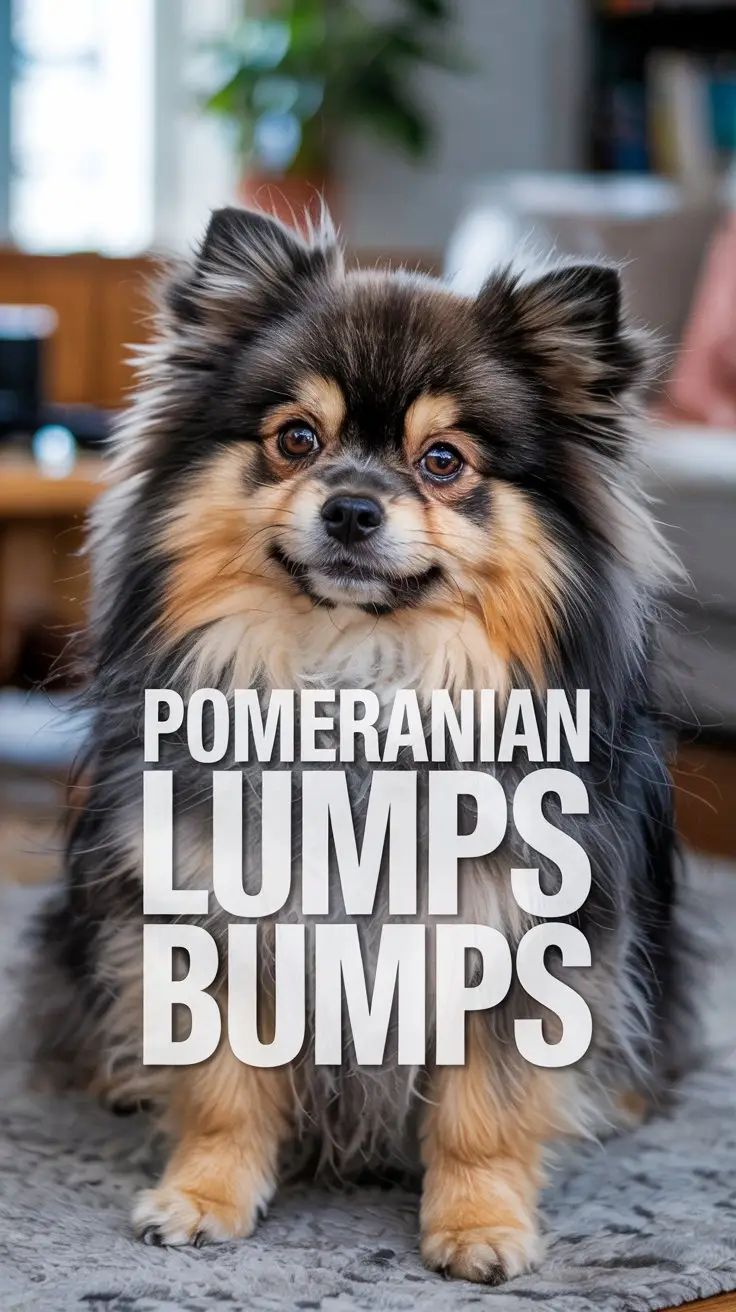Your Pom’s lumps and bumps can be anything from simple fatty deposits (lipomas) to trickier growths.
You’ll spot them mostly on their neck, chest, and legs – and hey, most of them are nothing to worry about and grow super slowly.
💸 Finding mysterious lumps on your Pom is a when, not an if situation
👉 See which insurance plans actually cover diagnostic testing and tumor removal because that “wait and see” approach can turn expensive, fast.
Keep an eye out for warning signs like quick growth, weird color changes, or funky shapes – these mean it’s time to head to the vet ASAP.
It’s a good idea to check your pup over while you’re grooming them each month, and using a slicker brush makes it way easier to feel for anything new.
Sure, stuff like sebaceous cysts and skin tags are usually no big deal, but keeping tabs on things and getting regular vet check-ups is the best way to keep your Pom happy and healthy.
These tips will make you a pro at spotting and dealing with your Pom’s skin stuff.
Common Lumps in Pomeranians
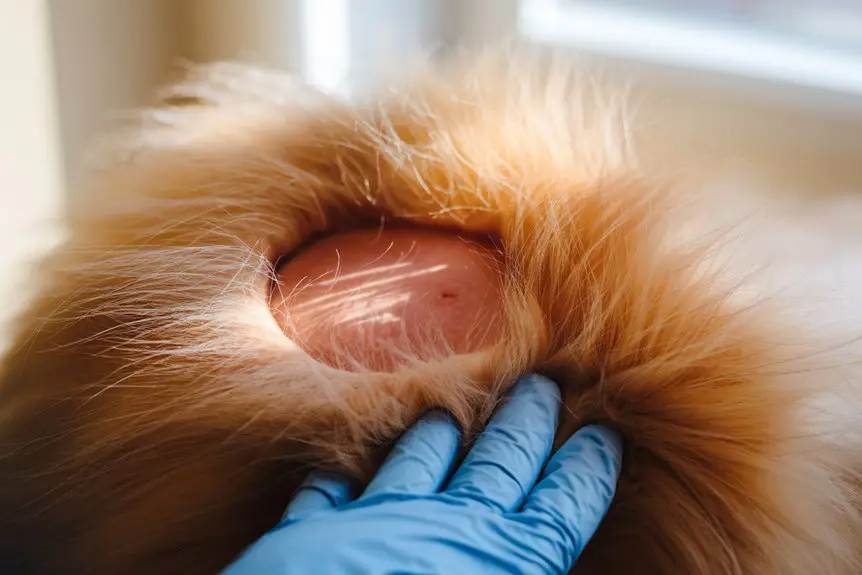
Most Poms get five kinds of lumps: lipomas, sebaceous cysts, dental epulis, skin tags, and warts. Lipomas are just soft, squishy fatty lumps that move around easily under your pup’s skin – they show up a lot in older or chubby dogs. Those sebaceous cysts are like little oil-filled bumps that usually don’t cause trouble, but they can get irritated if they get infected. When your Pom gets dental epulis, these lumps pop up on their gums or mouth tissue, and they might make it hard for your buddy to eat if they get too big.
Skin tags are basically tiny bits of extra skin that hang off – older Poms tend to get these more often, and they’re usually no big deal unless something rubs against them. As for warts (or papillomas), these pop up because of viruses and usually go away by themselves. But if they’re bugging your pup too much, you might need to get them removed at the vet. Routine inspections monthly can help catch any concerning changes in these lumps early.
Understanding Benign Tumors
Finding a lump on your Pom can freak you out, but don’t panic – most bumps aren’t dangerous. These harmless growths just hang out in one spot and usually take their sweet time getting bigger.
Your Pom might get these common non-scary lumps:
- Lipomas – squishy, fatty lumps that move around when you touch them
- Sebaceous cysts – oily bumps that might get a bit red but are mostly just annoying
- Dental epulis – lumps on the gums that might bug your pup when eating if they get big
- Skin tags – tiny, extra bits of skin that older Poms tend to get
Even though these lumps are usually no big deal, it’s smart to let your vet check out any new bumps just to be sure everything’s okay and keep an eye on them. Regular dental check-ups are particularly important since Pomeranians are prone to various oral health issues that can cause gum lumps.
Dental Health Concerns
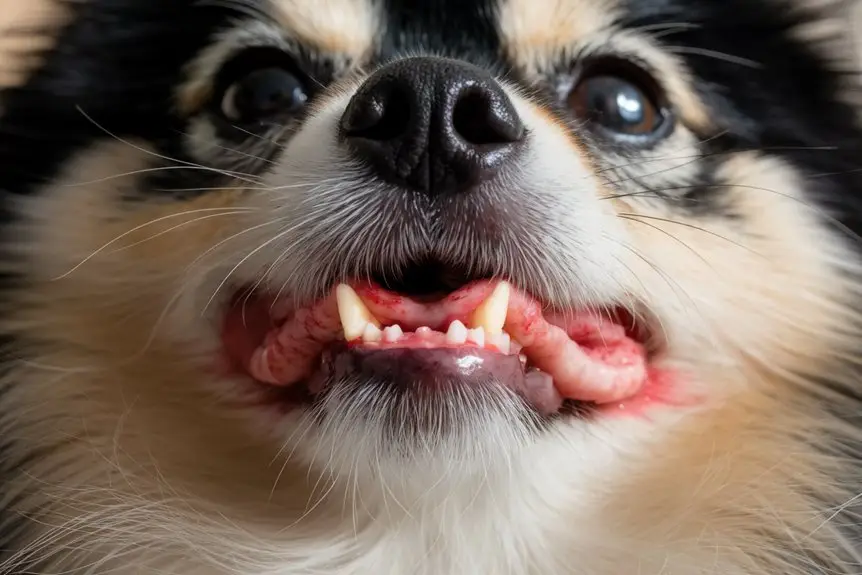
Hey, your Pom’s teeth need extra care since these little pups often run into mouth problems, including those pesky epulis bumps on their gums. These are slow-growing lumps that can pop up on your furry friend’s gums or soft tissue in their mouth. No need to panic – they’re usually harmless, but they can make it tough for your pup to eat if they get too big.
Keep an eye out for any weird lumps in your Pom’s mouth, and watch if they’re having trouble eating, getting bloody gums, stinky breath, or wiggly teeth. Don’t sit on it – give your vet a call right away since catching it early makes a big difference. Most times, they’ll need surgery to remove the growths while your pup’s under anesthesia, and sometimes they might need radiation treatment too. After that’s done, you’ll want to stay on top of brushing their teeth and keeping their mouth clean to avoid more problems down the road.
Skin Conditions and Care
Hey, your Pom’s skin bumps need checking out – these little fluff balls often get different kinds of lumps and bumps. When you’re feeling around under all that fur, you might run into several types that need different kinds of attention.
Keep an eye out for these common skin issues:
- Lipomas – these are just fatty lumps that feel squishy and move around under the skin
- Sebaceous cysts – basically oil-filled bumps that can get red and angry
- Skin tags – your older Pom might get these, especially around their neck and chest area
- Warts – these little guys can pop up out of nowhere but sometimes go away on their own
If you spot anything growing fast, changing color, or if your pup seems bothered by it, get to the vet! Pro tip: while you’re brushing and grooming your furry friend, it’s the perfect time to check for any new bumps or changes. Just like with anal gland issues, remaining calm during examinations is essential since your dog can sense your anxiety.
Warning Signs and Symptoms
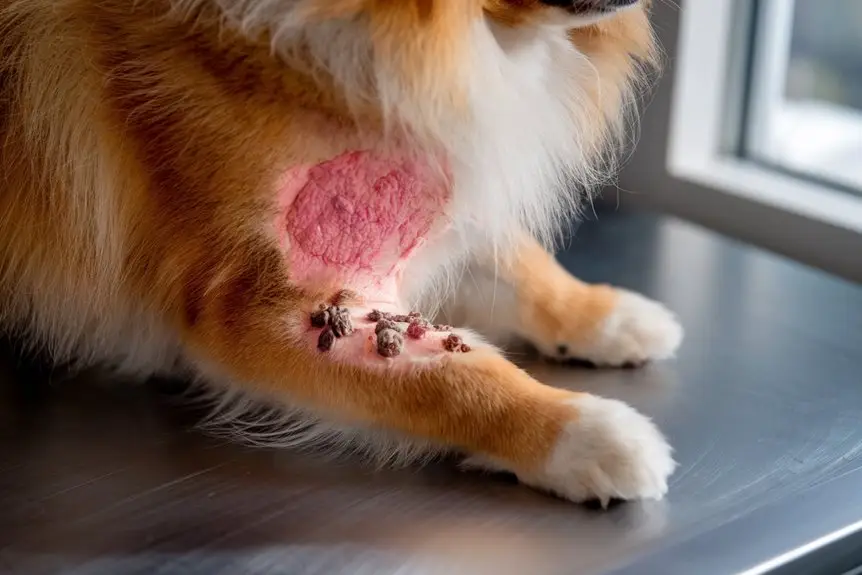
Hey there! Looking after your Pom means keeping an eye out for any weird lumps and bumps – it’s super important to catch things early. Just watch if any bumps start growing fast, change size, or look funky in shape. Red, hot, or swollen spots around the area? That’s your cue to get it checked out since it might mean there’s an infection or something’s not right.
Keep track if your pup acts differently when you touch certain spots, seems in pain, or keeps licking one area too much. If you spot any dark or multi-colored lumps, see blood, or notice open sores, don’t wait around – head straight to the vet. Same goes for any hard lumps or ones that seem stuck to the tissue underneath. Sure, most bumps turn out to be nothing serious, but if you notice any of these signs or they show up together, it’s better to let a vet take a look. Better safe than sorry when it comes to your furry friend! Positive reinforcement training can help your Pom stay calm during physical examinations when checking for lumps and bumps.
Treatment Options
Treatment options for your Pom’s lumps and bumps really come down to what’s causing them. After your vet figures out exactly what kind of growth it is, they’ll let you know the best way to handle it based on things like how big it is, where it’s located, and how serious it is.
Here’s what usually works:
- Surgery to remove scary-looking growths, tooth-related lumps, or big cysts that are bothering your pup
- Antibiotics and draining for infected spots or abscesses
- Antihistamines or steroids if your dog’s having allergic reactions or inflammation
- Just keeping an eye on harmless lumps like fatty tumors or tiny skin tags through regular vet visits
If it turns out to be cancer, your vet might need to go with stronger treatments like chemo or radiation. Just remember – the sooner you get these things checked out, the better chance your pup has of getting better, so don’t wait around if you spot any weird bumps on your Pomeranian.
Prevention and Early Detection
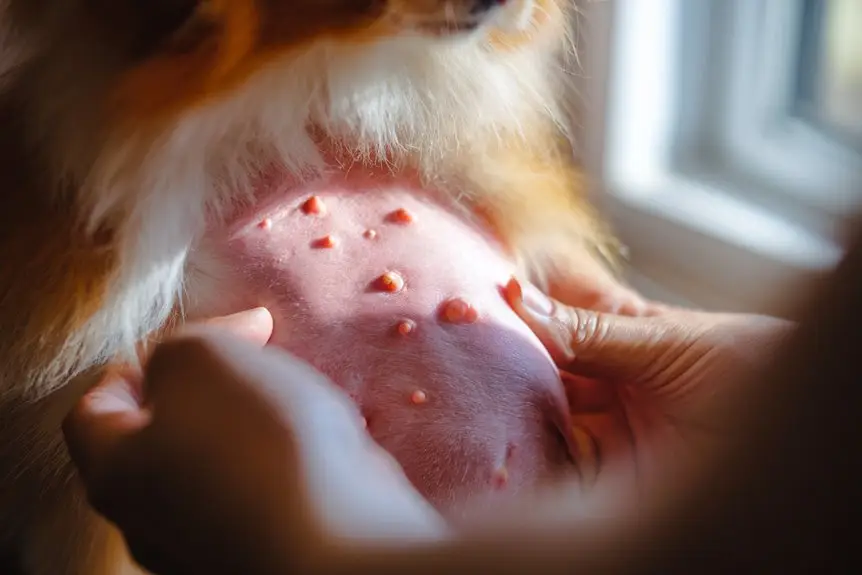
Checking your Pom regularly is super important to catch any weird lumps or bumps early on. Just run your hands through your pup’s fur about once a week to feel if anything seems off or different. Make sure to really check areas like their neck, chest, and legs since that’s where stuff often shows up.
Keep up with those vet visits – they’re a must! While you’re grooming your furry friend, take a good look at their skin and maybe jot down notes about any bumps you find – how big they are, where they are, and what they look like. If you see something growing fast, changing color, or if your Pom seems bothered by it, give your vet a call right away. Oh, and keeping your pup at a good weight with the right food can actually help stop some kinds of lumps from popping up. Since Pomeranians typically have a 12-16 year lifespan, maintaining regular health checks throughout their life is crucial for early detection of any issues.
Home Monitoring Techniques
A simple way to keep tabs on your Pomeranian’s lumps and bumps is to make it part of your regular routine. Just check your pup’s skin while you’re grooming them – it’s super easy to spot anything new or different this way.
- Just run your fingers through your Pom’s fluffy coat to feel for any weird bumps or spots
- Jot down what you find (size, shape, where it is) in a notebook or on your phone
- Snap some pics of anything that looks odd so you can see if it changes
- Keep an extra eye on spots like the neck, chest, and legs – that’s where stuff often shows up
Try to do this once a month at least. If you see something growing fast, looking red, or if your pup gets fussy when you touch it, give your vet a call right away. No need to stress – just make it part of your regular cuddle time with your furry friend! Using a slicker brush during your check-up routine will help you better detect any abnormalities while simultaneously managing your Pom’s coat.
Veterinary Care Guidelines
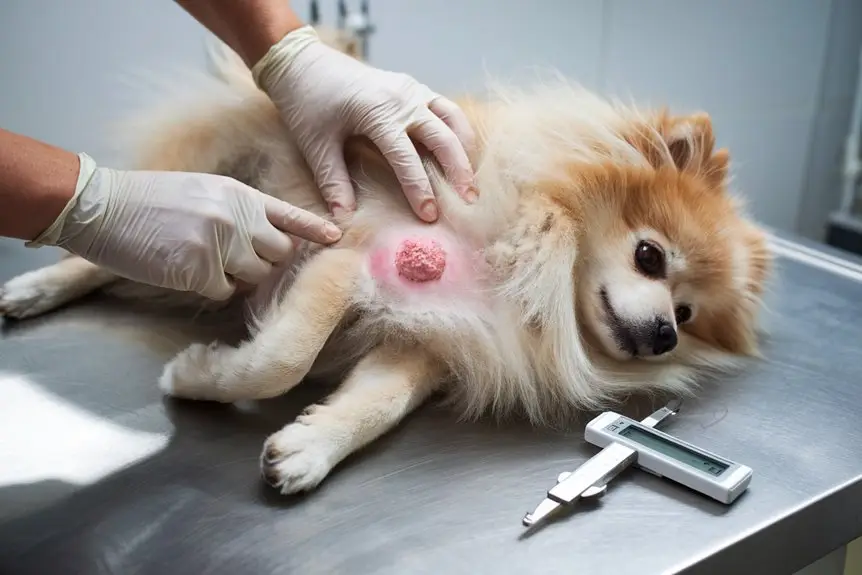
Going to the vet is super important when dealing with any lumps or bumps on your Pom. If you spot anything weird growing on your pup, don’t wait around – just head straight to the vet. They’ll check everything out and might need to do some tests like taking samples or doing a biopsy to figure out what’s going on.
Once they know what they’re dealing with, your vet will come up with a plan just for your dog. They might need to cut out some worrying growths, give antibiotics if there’s an infection, or just keep an eye on harmless lumps. For those pesky mouth growths (epulis), they’ll let you know if surgery is needed, and those oily cysts might need draining or removing if they get infected. Feel free to ask them anything – like how long recovery takes or what care your pup needs afterward. Keep up with regular vet visits so they can watch any existing lumps and catch new ones early – it’s the best way to keep your Pom healthy!
Recovery and Management
Taking care of your Pom after they’ve had lumps or bumps treated is super important for them to get better. Keep an eye on where they had surgery every day – look out for any signs it might be infected, red spots, or weird stuff coming out. Make sure to keep it clean, and if your little furball tries to scratch or lick the area, you might need to put one of those cone collars on them.
Some key things to remember:
- Give them their meds exactly when the vet says to – this includes pain meds and antibiotics
- Set up a cozy, quiet spot for them to rest away from other pets and too much excitement
- Don’t skip those check-up visits – they help make sure everything’s healing right
- Watch how they’re eating, drinking, and doing their business while they get better
If something doesn’t look right or your Pom isn’t bouncing back like they should, just call your vet right away. Better safe than sorry!
Maintaining proper dental hygiene during recovery can help prevent additional health complications and infections that might slow healing.
Frequently Asked Questions
Can Stress or Anxiety Cause Temporary Lumps in Pomeranians?
Yep, your Pom can get these funny lumps when they’re feeling super stressed out or worried. You might spot some puffy spots or bumpy patches on their skin – but don’t freak out! These usually go away on their own once your furry buddy chills out and feels better.
Do Pomeranians Inherit a Predisposition to Certain Types of Lumps?
Your little Pom may look super cute and fuzzy, but their DNA comes with some baggage! These pups tend to get lumps like lipomas, sebaceous cysts, and dental epulis – it’s just part of who they are genetically. No need to panic though – it’s pretty common stuff for the breed!
How Does Seasonal Weather Affect the Appearance of Skin Bumps?
You’ll get way more bumps on your skin when it’s hot and sticky outside – that’s when your skin acts up and gets super irritated. When temperatures drop, your skin can get all dry and scratchy, and once spring comes around, those pesky allergies show up and make your skin go crazy.
What Role Does Grooming Frequency Play in Preventing Lumps?
Hey, grooming’s your best buddy here – just like having a trusty guard watching your back! When you brush regularly, you keep those pesky mats away, catch any problems super early, and help your pet’s skin stay happy and healthy. Getting in there with a brush once a week means you’ll notice those little bumps before they turn into big ones!
Can Dietary Supplements Help Reduce the Occurrence of Certain Bumps?
You know, taking stuff like omega-3s and vitamin E might help keep your skin in good shape, but they’re not magic pills that’ll stop bumps from showing up. Your best bet is to just eat a good mix of healthy foods and make sure you get those regular check-ups with your vet to stay on top of any lump issues that pop up.

